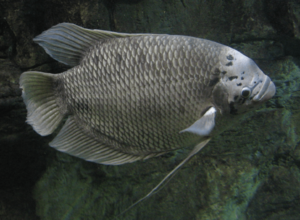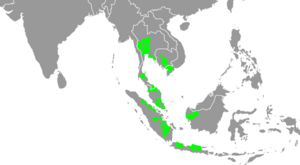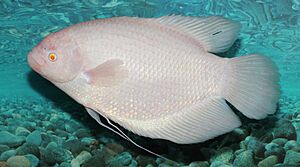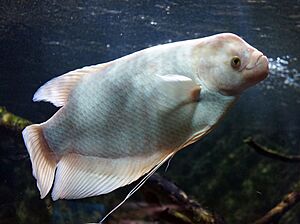Giant gourami facts for kids
Quick facts for kids Giant gourami |
|
|---|---|
 |
|
| Adult | |
| Conservation status | |
| Scientific classification | |
 |
|
| Native range in green (widely introduced elsewhere, not shown) | |
| Synonyms | |
|
The giant gourami (Osphronemus goramy) is a very large type of gourami fish. It naturally lives in freshwater places in Southeast Asia. People have also brought it to many other parts of the world. This fish is important for food and is raised on farms. You can also find it in aquariums as a pet. Sometimes, giant gouramis are used to help control unwanted water plants, like Salvinia molesta, because they eat a lot of plants.
Giant gouramis can breathe moist air. This means they can stay alive out of water for a long time. They are much bigger than most other gourami fish. Only a few other Osphronemus species grow to a similar size. A giant gourami can grow up to 70 centimeters (about 28 inches) long. However, most are around 45 centimeters (about 18 inches) long.
Contents
Where Giant Gouramis Live
Giant gouramis originally come from rivers, streams, marshes, swamps, and lakes in Southeast Asia. This includes places like the lower Mekong River in Cambodia and Vietnam. They also live in the Chao Phraya and Mae Klong rivers in Thailand. You can find them in river areas in the Malay Peninsula, Sarawak in Malaysia, and Java, Sumatra, and Western Kalimantan in Indonesia.
It can be tricky to know their exact natural home. This is because they look similar to other Osphronemus species. Also, people have released giant gouramis in many places outside their original homes. For example, some fish found in the middle Mekong River that were thought to be giant gouramis might actually be elephant ear gouramis.
People have moved giant gouramis around a lot, sometimes on purpose and sometimes by accident. This was often done because they are a good food fish. In Asia, they now live from southern China to India and Sri Lanka. On other continents, they are found in Australia, Mauritius, Réunion, and Madagascar. Moving these fish around Southeast Asia probably started a very long time ago. Even Europeans recognized how valuable they were as food fish hundreds of years ago.
Giant Gouramis as Aquarium Pets
Giant gouramis are also popular fish to keep in aquariums.
Setting Up Their Tank

When setting up a tank for them, people often use dark sand or gravel at the bottom. They also plant many plants around the edges of the tank. This leaves an open space in the middle for the fish to swim. Giant gouramis like to be with other fish that are about the same size and have a calm nature.
Young gouramis, around three months old and 7.5 cm (3 inches) long, are easy to care for. At this age, they have a noticeable "beak" shape to their mouth. They can grow very quickly if they have enough food and space to move around. Even if conditions are not perfect, a gourami can grow from 7.5 cm to 50 cm (about 20 inches) in four years. When they get older, they develop a rounded face and a small hump above their eyes.
Giant gouramis can be a bit bossy. In a tank with other fish, they might chase or snap at smaller fish. It's best to keep them with larger, calmer fish. If new fish are added to their tank, the gourami might become aggressive towards them.
What Giant Gouramis Eat
Gouramis mostly eat plants. They prefer foods made from algae. However, they will also eat meaty foods. When they are young, they can eat flake food made from algae. They also like freeze-dried bloodworms, tubifex worms, and brine shrimp. Once they are bigger, you can feed them vegetables like legumes, or cooked starchy vegetables and fruits.
Reproduction and Life Cycle
Giant gouramis lay eggs. They build a nest using plant fibers. Both the male and female fish help build the nest, but the male usually does more of the work. You can tell males and females apart by their dorsal fins and body color. The male's dorsal fin has a pointed end. His body also gets darker, almost black, when it's time to lay eggs.
After the nest is built, the eggs will be laid within 24 hours. For breeding, the water in the tank should be about 20 cm (8 inches) deep. The temperature should be around 28 °C (82 °F). After the eggs are laid, the female should be moved to a different tank. The male will protect the eggs very carefully and might become aggressive towards the female in a tank. The eggs hatch in about 24 hours. The baby fish should be kept in a dark aquarium.
Giant Gouramis as Food
Because of its large size, the giant gourami is an important food fish. In the places where it naturally lives, people have eaten it for a long time. In Southeast Asian cooking, gourami is highly valued. People like its thick flesh, nice texture, and tasty flavor. Unlike fish like carp and milkfish, gouramis do not have many tiny bones in their meat. This makes them easier to eat and increases their value. In Southeast Asian markets, gourami is one of the most expensive freshwater food fish. Gourami meat is also full of protein and important minerals.
It is a popular food fish in Indonesian, Malaysian, and Thai cuisine. Gouramis are especially popular in Sundanese cuisine in Indonesia. There, they are often fried as ikan goreng, grilled as ikan bakar, or cooked with spices inside a banana leaf wrap as pepes. In some parts of Southeast Asia, they are salted to keep them fresh for longer.
Images for kids
-
Gurame bakar (grilled gourami)





